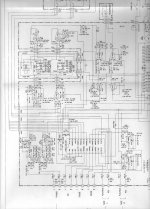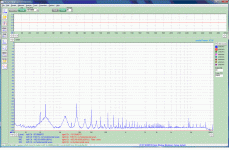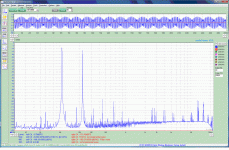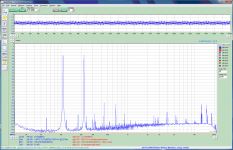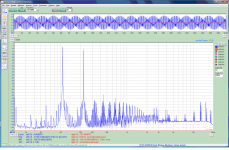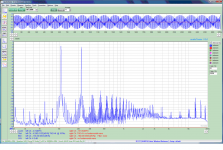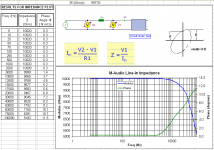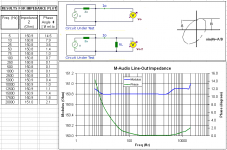Mmm, perhaps this is the crux of where the difference lies, I suggest there is no missing musical information, at least as far as they are concerned.
Yes what I mean is that through let’s say a mass market FM radio with a 1” speaker, those I’m mentioning seem to be able to assemble in their minds how it might sound live, in real time, as a result of their musical training. They ignore the limitations of the playback device and make up for it in their noggin. They are focusing on the artistry of the player(s) more than let’s say the reviewer buzzwords we are all familiar with. At least, that’s how they’ve described it to me. Of course there’s some metaphor rolled up in there.
I’ve seen this mostly with classically trained musicians- strings, brass, piano etc. Less so with those trained on amplified instruments- electric guitar and bass.
Just a curious observation.... a tendency rather than a rule.
Maybe the way you would talk to one of your guys at work to get them thinking?
I usually didn't have to. I mention it before this is old hat for me, my product engineer/tech and I told Alcatel that their (the original roll out of ADSL) design had to use film caps to couple to the tip and ring transformer due to the -60dB multi-tone distortion in their original parts. They were quite annoyed at adding $2-$4 for those big brown caps. The problem was that the separation of POTS from the xDSL necessarily had lots of AC voltage on the caps. High voltage high K ceramics don't cut it, if it hurts stop doing it.
I agree with Richard on what is wrong with caps. Unfortunately almost everybody here seems to forget WHY Richard and I, along with many circuit designers have designed out caps (electrolytic mostly) from our audio circuits and have instead used servos where they are necessary.
A PP cap at the input of an amplifier is usually unnecessary, and that is one good reason to omit it. This is not a new concept. Even the Dyna tube power amps from the 1950's did not have an input cap. It is more like adding suspenders to a belt, than adding really necessary protection.
Yet, many of you just don't see where the electrolytic caps are necessary, without a servo, and that is mainly in the FEEDBACK LOOP to ground, in order to remove the forward gain of the stage at DC. Here is where 'the rubber hits the road', not on an input cap addition. This is where the load resistance is the LOWEST in order to preserve low noise performance, and an electrolytic cap is almost MANDATORY without a servo. Nowhere else. Look again at the commercial preamp schematic that I put up, note at the electrolytic caps used in the feedback loops and note what they have as a load. This is the primary place that caps can really show their lack of ideal behavior.
The addition of servo generally removes 3 electrolytic caps from phono stages and 1-3 electrolytic caps from a line stage. They add up, even in an inexpensive preamp.
You might think that this design is 'dated' because it is over 20 years old, but replace the AD712 in the phono stage with a 5532 and you might have a good example of one of today's IC based phono stage that most people use. Yet, a servo would remove 3 electrolytic caps from the phono stage alone, and this would improve the sound quality, from my experience. Why not just do it?
A PP cap at the input of an amplifier is usually unnecessary, and that is one good reason to omit it. This is not a new concept. Even the Dyna tube power amps from the 1950's did not have an input cap. It is more like adding suspenders to a belt, than adding really necessary protection.
Yet, many of you just don't see where the electrolytic caps are necessary, without a servo, and that is mainly in the FEEDBACK LOOP to ground, in order to remove the forward gain of the stage at DC. Here is where 'the rubber hits the road', not on an input cap addition. This is where the load resistance is the LOWEST in order to preserve low noise performance, and an electrolytic cap is almost MANDATORY without a servo. Nowhere else. Look again at the commercial preamp schematic that I put up, note at the electrolytic caps used in the feedback loops and note what they have as a load. This is the primary place that caps can really show their lack of ideal behavior.
The addition of servo generally removes 3 electrolytic caps from phono stages and 1-3 electrolytic caps from a line stage. They add up, even in an inexpensive preamp.
You might think that this design is 'dated' because it is over 20 years old, but replace the AD712 in the phono stage with a 5532 and you might have a good example of one of today's IC based phono stage that most people use. Yet, a servo would remove 3 electrolytic caps from the phono stage alone, and this would improve the sound quality, from my experience. Why not just do it?
Attachments
Maybe I'm doing this wrong, but the only caps I can see that distort badly are Al electrolytic and PP in oil Motor Run caps.
I summed two signals with 600R limit resistors and fed the resulting signals through various caps, into my computer sound card to look at the results.
The first image is without the sound card 107Hz signal and IG-18 209Hz signal turned on.
The second image is with the both signals on, but nothing in the path except the test leads.
The third image has the Sprague 0.1uf Vitamin Q cap in series with the signals.
The fourth image is with a GE Dielektrol V 3uf 66ovac PP in oil motor run cap.
The last image is with a Sprague 5uF 25V AL electrolytic without bias.
I summed two signals with 600R limit resistors and fed the resulting signals through various caps, into my computer sound card to look at the results.
The first image is without the sound card 107Hz signal and IG-18 209Hz signal turned on.
The second image is with the both signals on, but nothing in the path except the test leads.
The third image has the Sprague 0.1uf Vitamin Q cap in series with the signals.
The fourth image is with a GE Dielektrol V 3uf 66ovac PP in oil motor run cap.
The last image is with a Sprague 5uF 25V AL electrolytic without bias.
Attachments
Last edited:
Maybe the way you would talk to one of your guys at work to get them thinking?
Maybe more likely to lead back to more arguing here. Different situation.
Wow. Do you think you could stop trying to be the den mother here for five minutes? It is not helpful and is extremely irritating. (See? Was my comment on your tone useful or pleasant?)
They enjoy it, isn't it obvious? No one is making them do it.
Same for the family down the street right? The place with broken windows? They enjoy it!
Last edited:
Maybe I'm doing this wrong, but the only caps I can see that distort badly are Al electrolytic and PP in oil Motor Run caps.
The fourth image is with a GE Dielektrol V 3uf 66ovac PP in oil motor run cap.
The last image is with a Sprague 5uF 25V AL electrolytic without bias.
yep. caps with higher DA and higher distortion and worse sound.
Use just the low DA film types for audio. That was back then and is now the same message.
-RNM
Last edited:
George,
Am I missing something, I don't see a load resistor on the right input to the shell (ground.)
You are right Ed. I haven’t placed any external load resistor, as the card’s input impedance is 10kOhm, see first attachment.
The card’s output impedance (signal source) is 150 Ohm, see second attachment
George
Attachments
Not really, they might be trapped, no one is trapped here. I remember someone a while ago on this forum said "these are not real conversations, we are all hiding behind our keyboards", I think he had a point.
Where else is there for audio engineers to hang out with other audio engineers? Leaving here might mean leaving a bunch of people a lot like you, people that think in terms of science and engineering. Not so many to talk to down at the corner pub.
But, you can go there, grab a drink, and still watch wrestling.
I know people have left, and I don't know what to say about that other than it's sad, and, to my mind, a bit unnecessary. In my experience, things pass, but again, this is not real like that, these posts (generally) remain, but, so what? Perhaps if you have a reputation to maintain it's important, I'm lucky in that way
Last edited:
I was hoping I could see the difference between Mylar, PP film and PIO capacitors.
Unfortunately my setup does not reveal any difference between them.
As near as I can see, they all appear the same as the Vitamin Q.
Start here, first --- Picking Capacitors - Walter G. Jung and Richard Marsh
Then to direct-coupled topologies and then to dc servo.
Then to CFA's.
THx-RNMarsh
Last edited:
Say, I understand at one time there used to be some industry luminaries around here (besides Scott), but some left because they didn't like the way people sometimes carry on.
We could use some more tag team action here, I'm tired of it and I'm thinking of just doing the Ed thing and posting some carefully taken data "just for fun" of how to use 25 cent non-polar electrolytics as input coupling caps. BTW SY's data is just fine unless you want to call him a liar the $400 Teflon cap and the back to back 25 cent electrolytics are identical with just slight care in selecting the high pass frequency.
Here comes 'da Crusher
YouTube
I was hoping I could see the difference between Mylar, PP film and PIO capacitors.
Trust yourself.
SY's data is just fine
I expect it is. It was the tone that I was talking about. The one other one-line comment was not actually meant to be about the quality of Sy's work.
Regarding conflicting claims by different people, they must either be looking at different parts, or measuring differently. Obviously. Don't know why we can't just make some progress getting to the bottom of it. Can't see any other way to get past it and move on.
Last edited:
- Status
- Not open for further replies.
- Home
- Member Areas
- The Lounge
- John Curl's Blowtorch preamplifier part III
